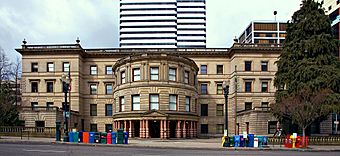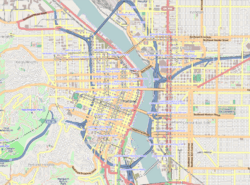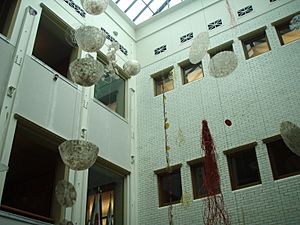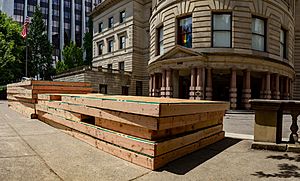Portland City Hall (Oregon) facts for kids
Quick facts for kids |
|
|
Portland City Hall
|
|
 |
|
| Location | 1221 SW 4th Avenue Portland, Oregon |
|---|---|
| Built | 1895 |
| Architect | Whidden & Lewis |
| Architectural style | Italianate, Renaissance |
| NRHP reference No. | 74001711 |
| Added to NRHP | November 21, 1974 |
Portland City Hall is the main building for the city government of Portland, Oregon, United States. This four-story building is designed in the Italian Renaissance style. It holds the offices of the City Council, which includes the mayor and four commissioners. Many other city offices are also located here.
The City Council chambers, where important meetings happen, are found in the rotunda on the east side of the building. Portland City Hall was finished in 1895. It was added to the National Register of Historic Places on November 21, 1974. The building has been updated several times. The most recent major renovation completely redid the inside. This made the building safer and stronger against earthquakes. The original building cost about $600,000 to build. The renovation from 1996 to 1998 cost $29 million.
City Hall is in downtown Portland. It takes up an entire city block between Fourth and Fifth avenues, and Madison and Jefferson Streets. The Wells Fargo Center is to the south. The Portland Building is to the north. Terry Schrunk Plaza, named after a former mayor, is across Fourth Avenue to the east. The building has over 87,000 square feet (8,082 square meters) of space inside. Outside, there are beautiful landscaped gardens. The main entrance is on Fourth Avenue.
Contents
History of Portland City Hall
Early Years (Late 1800s)
The City Hall building we see today, finished in 1895, replaced an older city building. In 1869, a school for girls called St. Helens Hall was on the same block where City Hall now stands.
The city first hired Henry J. Hefty to design the new building. His design was very grand and looked a bit like the Kremlin. The city bought the land in 1890 for $100,000. Construction started in 1892. However, people were not happy with the design. After the foundation and basement were built, the city stopped the project. They tore down the basement and first floor, which cost $125,000.
The city then fired Hefty. They hired the architectural firm of Whidden and Lewis to design a new building. Ion Lewis and William Whidden were from Boston. They were already in Portland working on the Portland Hotel. Whidden & Lewis designed a four-story building in a new Renaissance style. Their plans included a tall clock tower and a domed cupola. These were meant to be in the center of the building. But because of high costs, the clock tower and cupola were never built. People praised the new design for its details and balance.
Construction began again in 1893. The builders were Rocheford, Gould and Gladden from Omaha, Nebraska. To save money, City Hall was built with walls made of un-reinforced masonry. Its floors were made of a type of concrete called slurry concrete.
The new building was finished in 1895. City offices moved in during late January 1895. The first city council meeting in the new building was on February 6. When it was completed, City Hall was one of the first large buildings in the Pacific Northwest to have electric wiring. It also had centralized heating and public elevators. It was even considered fireproof. William S. Mason was the first Portland mayor to work in the new City Hall. About 34 people worked there when it opened. The next mayor, Sylvester Pennoyer, called the new building "expensive, unseemly and unhealthful."
The money for City Hall came from different places. In 1889, the Oregon Legislative Assembly allowed Portland to sell $175,000 worth of bonds. This helped pay for the new building. The building ended up costing $575,000.
When City Hall was built, the area around it had dirt roads and private homes. The Southern Pacific Railroad had a rail line that ran down Fourth Avenue. This line went past City Hall. The city and county governments worked to remove the noisy steam trains from this route. They succeeded in 1912. Electric trains continued to use the tracks until the 1930s. In 2007, work started to add light rail tracks on Fifth Avenue for the MAX Green Line. Trains began running past City Hall again in 2009.
Changes in the 1900s
In 1902, two Port Orford cedar trees were planted on the east side of City Hall. One tree was on the north side and the other on the south. This helped make the building look balanced. The south tree was replaced in 1999 because it was unhealthy. In 1910, the city added passenger elevators to the open stairwells.
Until 1902, the Portland Public Library was located in City Hall. In 1928, the city started making changes to the building to create more space. They filled in one of the two "light wells." These were open areas that let natural light into the lower floors. This blocked some of the natural light. The city added another elevator in 1931. More remodeling happened from 1933 to 1937. During this time, the second light well was also filled in for more space. A small apartment was built on the roof.
In 1910, a large boulder was placed on the southeast part of the grounds. The Oregon Railway and Navigation Company had found this 15,000-year-old boulder in 1897. It was moved to Portland. The ten-ton Wallula Stone was found in the Columbia River Gorge. It was covered with ancient rock carvings called petroglyphs. In 1996, it was returned to the Umatilla tribe of Native Americans in Eastern Oregon. The old elevators inside City Hall were replaced again in 1946. In 1948, a truck crashed into part of the stone railing on the Fifth Avenue side, which was then fixed.
In the 1960s, the mayor's office was updated. A new roof was put on, and new trees were planted outside. In 1964, the city remodeled the City Council chambers. Part of this work was to add new lighting so that meetings could be shown on television. Other changes included adding ceiling tiles, which covered up the domed roof.
In the early morning of November 21, 1970, a bomb exploded under the front porch of City Hall. It caused $170,000 in damage. No one was hurt, but windows were broken. The Council Chamber, which was above the blast, was damaged. All the columns of the porch were damaged and replaced. A replica of the Liberty Bell was completely destroyed. A new bell was bought for $8,000 and later moved to Terry Schrunk Plaza. No one was ever arrested or took responsibility for the bombing.
Later in the 1970s, Portland improved City Hall by adding fire sprinklers and smoke detectors. In 1973, the sandstone outside of the building was cleaned and sealed. This was done to stop moisture from damaging the stone. However, it was later discovered that this process was harmful. The silicon coating trapped moisture inside the rock. In 1974, City Hall was added to the National Register of Historic Places. The next year, the rooftop apartment was turned into a break room for employees. It even had an outdoor deck. In 1978, the city built a ramp to make the building accessible for people using wheelchairs.
The 1980s brought more updates. The auditor's office and the mayor's office were both renovated. Work on the mayor's office stopped when money ran out. The city also made the city attorney's office bigger. In 1982, the Portland Building was finished across the street. This allowed many city offices to move to one location. Work was also done on the outside of City Hall, and a new roof was installed. In 1985, the building started to switch from steam heating to a different system.
In January 1995, the City Council voted to remove parking from the City Hall grounds. Before this, the landscaped yard around the building had been paved. This allowed city council members to park their cars there. That same month also marked the 100th birthday of the building.
Big Renovation (1990s)
Talks about needing to update City Hall began in 1988. In 1994, ideas were suggested to remodel the building. The goal was to meet modern building codes, especially for earthquakes. This was estimated to cost $16 million. The work would include replacing the concrete floors and making the structure stronger. It would also restore the original "light corridors." These were open areas that went through all four floors of the building. In March 1995, plans were made to renovate the 100-year-old building. The $22-million project was needed because the building did not meet city codes for earthquakes and fires.
Some preparation work for the renovation started in November 1995. On May 3, 1996, City Hall closed. Offices moved to a temporary location nearby. Bing Sheldon was the architect for the remodel. Drake Construction was the main builder. SERA Architects was the design firm.
On June 17, 1996, a 120-foot (37-meter) part of a construction crane fell at the building site. It scraped the stone on the east side of the building. Luckily, no one was hurt. Because the sandstone outside is fragile, the damage on the rotunda was not fixed. In January 1997, construction crews finished tearing down parts of the old interior. They then finished making the building stronger before starting the new inside construction.
Designers brought back the light corridors inside the building during the remodel. These two central open areas let more natural light into the building. Also, the old Fourth Avenue entrance was restored. The building's address was changed to 1221 S.W. Fourth Avenue. The renovations also brought back the original look of the City Council chamber. Now, council members face the windows.
The original red and white marble from the floors was saved. It was put back on top of the new concrete floors. New marble was used on the fourth floor. Other changes included adding central air conditioning. The roof and outside walls were insulated. The old single-pane windows were replaced. Public restrooms were added on the east side of each floor. During construction, the usable space in the building was reduced.
The inside restoration included work on the iron stairwell railings. Copper plating that decorated the stairwell walls was uncovered. Work was also done on the iron frames of the elevator shafts. Almost 40% of the building's steel structure was replaced. The plumbing was replaced, and new heating and cooling systems were added. Concrete slabs replaced the old concrete floors. New electrical systems were installed. Strong concrete walls were added. New security, fire, and safety systems were also put in place.
On March 30, 1998, City Hall reopened to the public. There were some worries about the cost of the project. It increased from about $15 million to almost $30 million. The city had approved $28.1 million before the project started. The final cost was $29.3 million. Of that, construction costs were $19.9 million. About $17 million of that was to make the building meet modern fire and safety rules. Extra money was spent on artwork, temporary offices, and new furniture. Reasons for the extra costs included new problems found during the remodel. Also, the construction market was very busy at the time, and there were delays in starting the project.
The renovations were paid for with local bonds. About $3 million per year came from the city's general fund to pay off this debt. Earlier attempts to raise private money for the project had failed. The project was named the top public project in 1998 by Northwest Construction magazine. It also received an honorable mention in the renovation category.
Building Details
Portland City Hall is a four-story building. It is built in the Italian Renaissance style of architecture. The outside is made of sandstone. The inside of City Hall covers 87,500 square feet (8,129 square meters). About 48,128 square feet (4,471 square meters) of this is usable space. The building is 180 feet (55 meters) wide along Fifth Avenue.
If you look at the building from above, it looks a bit like the letter E. The rotunda is the middle part that sticks out. There are two wings that reach towards Fourth Avenue. One is on the far north, and the other is on the far south. Each of these wings is only one story tall where it is closest to Fourth Avenue. The rotunda is three stories high. The portico, or front porch, makes up the first floor. Granite columns from Scotland support the portico. The Portland City Council chambers are on the two upper floors inside the rotunda, on the east side of the building.
On the roof of City Hall, there are 4-foot (1.2-meter) tall decorative urns. These were originally made of limestone. During the last remodel, they were replaced with lighter material for safety. The building has dentil molding where the roof meets the walls. The fourth floor has a balcony with paired columns on the west side. The outside also has keystones above the windows on the first and second floors. There is also a decorative railing along the roof line. Inside the building, the columns in the lobby are covered with a fake marble coating called Scagliola. The lobby has marble floors and oak wood details. In the open central areas, the walls are covered in white tile. This tile was rediscovered during the 1996 remodel.
The Pettygrove Room on the second floor is named after Francis W. Pettygrove. He was a founder of Portland. He won the coin toss to name the city. The main stairway at City Hall has 77 steps. It has iron handrails and tile steps. The building sits 70 feet (21 meters) above sea level. Artwork in the building includes pieces by Norie Sato. There is a mural by Michael Brophy in the Council Chamber. A changing art display called the "Visual Chronicle of Portland" is on the main floor. There are also other changing exhibits.
The Governmental Relations office and the city attorney's office are on the fourth floor. On the third floor are the mayor's office, the special Rose Room, a balcony for the Council chambers, and Audit Services. The second floor has the city council chambers, two meeting rooms, and offices for four commissioners. On the main floor is the lobby, an information desk, and offices for the city auditor, council clerk, and city treasurer. The grounds around the building include a rose garden, trees, a vegetable garden, and other plants.
See also
 In Spanish: Ayuntamiento de Portland (Oregón) para niños
In Spanish: Ayuntamiento de Portland (Oregón) para niños







